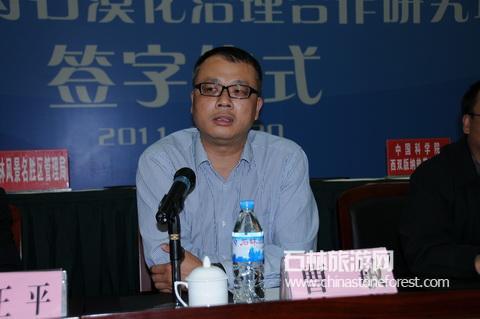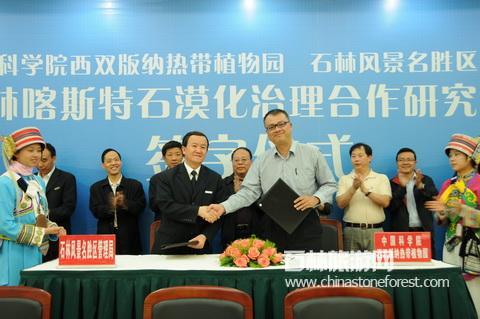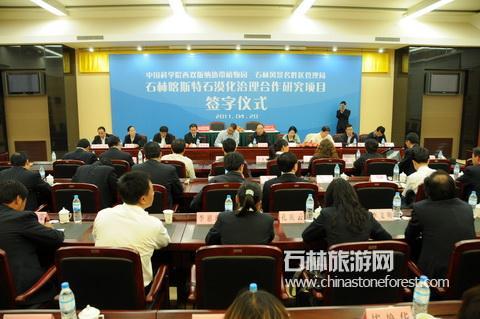- Letter to Inbound Travelers Entering Yunnan Directly or via Other Chinese Cities
- Welcome to Celebrate National Day at Stone Forest...
- Shilin County Will Host 2019 China Shilin Torch Carnival
- Enjoying Seafloor 300 Million Years Ago ...
- Lifetime Free Visit to Stone Forest for People Who Invest or Purchase House in Shilin from Jan. 1, 2019
- Slovenian Karst Experts Visited Stone Forest for Geological Relics Investigation
- “Travel in Yunnan with Cellphone” Lancang-Mekong Experience Officers Visited Stone Forest
- [Food]Wild Mushroom
- [Food]Fermented Bean Curd
- [Food]Gastronomies of Stone Forest
- [Food]Buckwheat Pan Cake
- [Food]Hot Pot
Banna Tropical Botanical Garden and the Stone Forest Scenic Spot Cooperated on the Rocky Desertification
On April 20th, Chinese Academy of Sciences Banna Tropical Botanical Garden and the Stone Forest Scenic Spot Administration’s “the Stone Forest Karsts Rocky Desertification Remedy Research Project” signing ceremony was held in the Stone Forest, which was another milestone in the history of the Stone Forest Scenic Spot Reservation. The two sides will join hands to lead the Stone Forest Scenic Spot to the example and excellent base of the China’s Karsts Rocky Desertification Vegetation Restoration Region.
The area of the World Natural Heritage regions, World Geo Parks and National AAAAA scenic spots is about 350 square kilometers that are divided into Premium, Primary, Secondary and the Minor reservation regions, whose central area is about 120 square kilometers. At present, under the influences of climate, environment changes and economic society development, there is severe desertification caused by vegetation disappearance in south China Karsts regions. The Stone Forest is the representative of Karsts landforms, where there exists desertification to different degree. The vegetation diversity and soil erosion decline and it is difficult to maintain ecological environment construction, which threatens the effective protection measures towards the Stone Forest Karsts geography and the sustainable development on tourism. It has drawn a lot of attention of the higher level Party committees, local governments and relevant departments. Chinese Academy of Sciences Banna Tropical Botanical Garden is the well-known plant research institution and popular science education base, and also domestically prodigious scenic spots.
With the support of Kunming Branch of Chinese Academy of Science and Kunming Science and Technology, Banna Tropical Botanical Garden cooperated with the Stone Forest Scenic Spot Administration and carried out the remedy program study on the Stone Forest Karsts vegetation diversity reservation. The program aimed at screening and applying the local plants and explored the best mode and technique to be adopted on the Stone Forest desertification region’s native vegetation and to solve the contradictions among the speed of the vegetation recovery, scales, input and output, which provided the technology demonstration and study template to the Stone Forest and other similar places botanical diversity reservation and native vegetation recovery to promote the protection of the Stone Forest natural heritage.
Qingli Wang, the dean of Kunming Branch of Chinese Academy of Sciences, and Yankun Liu, the director of Kunming Technology and Science Bureau, presented the signing ceremony and claimed the requests on the study and fruits of the program cooperation.
Min Cao, the deputy director of Chinese Academy of Sciences Banna Tropical Botanical Garden, Zhengping Li, the member of the standing committee and the dean of the Stone Forest Scenic Spot Administration, signed the agreement and made the statement on strengthening the cooperation and carrying out the program in-depth.
It was reported that the experimental period of the project was as long as 15 years, namely from March, 2011 to December, 2026. The main experimental field, barren hills as wide as 157.6 acres, between the opposite of the Stone Forest Scenic Spot ravine and the AIB Group Nectarine yard would be chosen.

Qingli Wang, the dean of Kunming Branch of Chinese Academy of Sciences addressed.

Yankun Liu, the director of Kunming Technology and Science Bureau.

Min Cao, the deputy director of Chinese Academy of Sciences Banna Tropical Botanical Garden, gave the keynote speech.

Zhengping Li, the member of the standing committee and the dean of the Stone Forest Scenic Spot Administration gave the keynote speech.

The signing ceremony

The signing ceremony spot
